New Delhi: A month after India’s air strikes on a Jaish-e-Mohammed camp in Balakot, Pakistan, the Australian Strategic Policy Institute (ASPI) has claimed that the Israeli-origin SPICE 2000 bombs used by the Indian Air Force missed their targets because the IAF incorrectly programmed the smart bombs.
However, the ASPI’s analysis is inherently flawed, and seems based on illogical assumptions.
ThePrint takes a close look at ASPI’s analysis and the satellite images it has used to explain the anomalies and the incorrect conclusions.
Incorrect assumptions
The biggest mistake committed by the ASPI authors is that they assume that the IAF did not use the correct information while feeding the GPS coordinates.
The IAF would have most certainly calibrated its systems and practised such strikes many times in various environments, including using simulators.
The ASPI article says that SPICE 2000 is a glide bomb and moves at an inclined trajectory, due to an exact error of 33m in the datum or information fed into them, the bombs fell elsewhere.
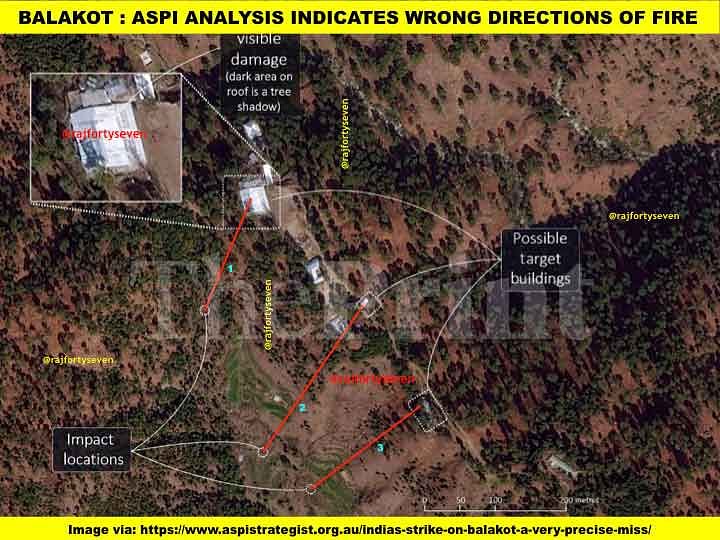
This is an illogical assumption since the JeM terrorist training camp at Jabba Top is located in a thickly-wooded forest with coniferous trees, which have grown much above the buildings (tree shadow indicated in the article).
It is incorrect to presume that IAF would have used an Angle of Impact anything below 80º to hit the designated targets in such a thickly-forested area.
Guidance system
The guidance system of the bombs used in this operation is not only based on GPS coordinates, but also on aerial photos and satellite images that are fed into the system as target information.
This duplication system of feeding target information increases redundancy, and thus increases the hit probability.
Changing possible target
The ASPI researchers have also changed the targets from their earlier report. The reasons for the same have not been explained in the new report.
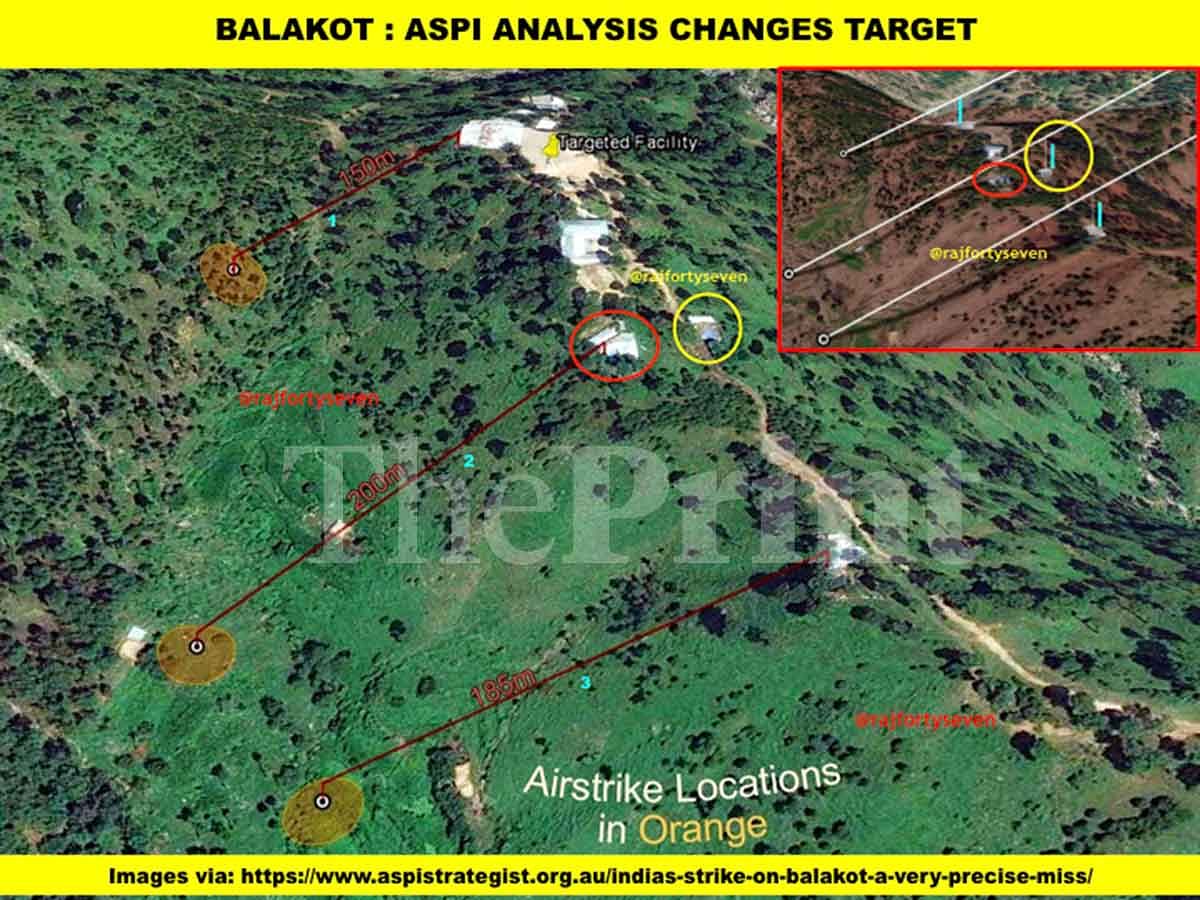
The length of the line denoting information difference in height has also been adjusted very clearly. The purpose of the changes made have not been explained anywhere either.
The elevation profile of the changed target clearly indicates that in such information difference of 33m, the impact location would have been further away.
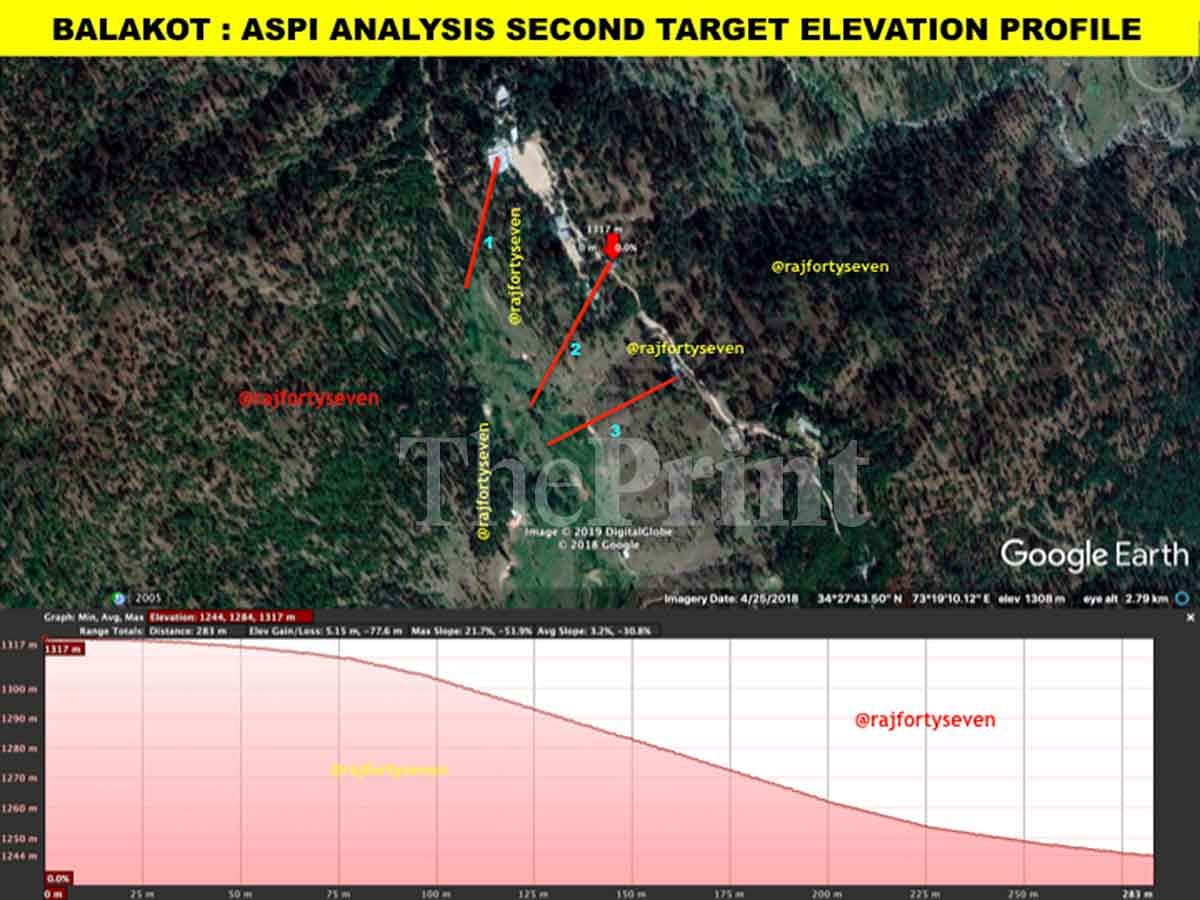
The target and length of information difference seems to have been changed on purpose, to ensure the angle of trajectory matches the trajectory drawn for other targets.
The only explanation for these changes is in order to modulate the data to match the analysis, which is a sign of shoddy research.
Also read: Image shows possible accident near Pakistani nuclear weapons facility after Balakot
Direction of fire
The analysis joins the lines of the possible targets and supposed impact locations and extends them to the IAF aircraft at a distance of 60 km, revealing surprising details.
The direction of fire, the analysis claims, is from 197º to 240º, which when extended to 60 km, indicates that the location of the aircraft would be much within Pakistan’s territory, without any valley to move along in a nap-of-the-earth (NOE) manner — a kind of flying where geographical features are used as cover.
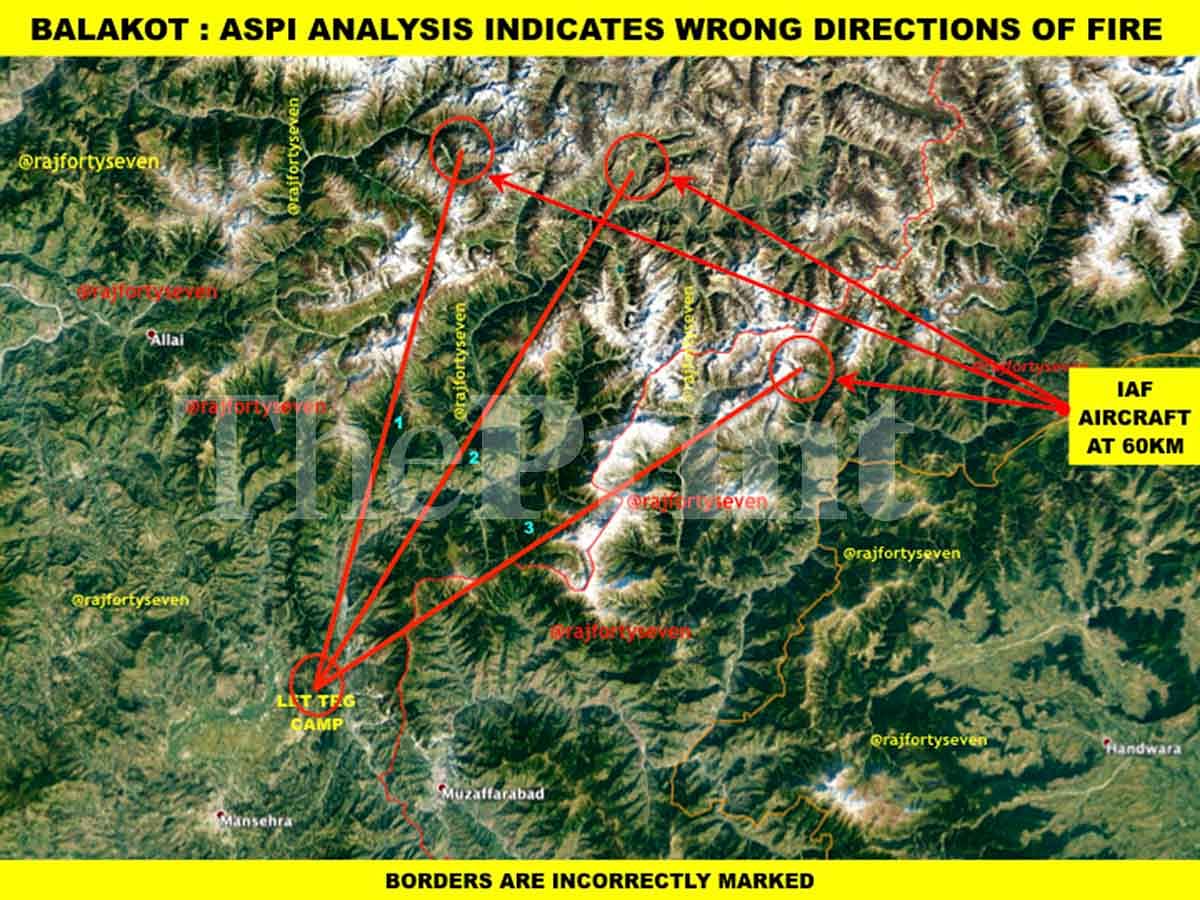
The three directions of fire the researchers propose, when plotted on Google Earth, would mean that the distance between the first and third aircraft was almost 45 km — which is impossible.
Air force aircraft move in particular formations during operations, and can never be 45 km apart in enemy territory. The researchers’ assumption is, therefore, far removed from the reality of a professional force like the Indian Air Force.
Also read: Pakistan’s entire navy has been out at sea after India bombed Balakot



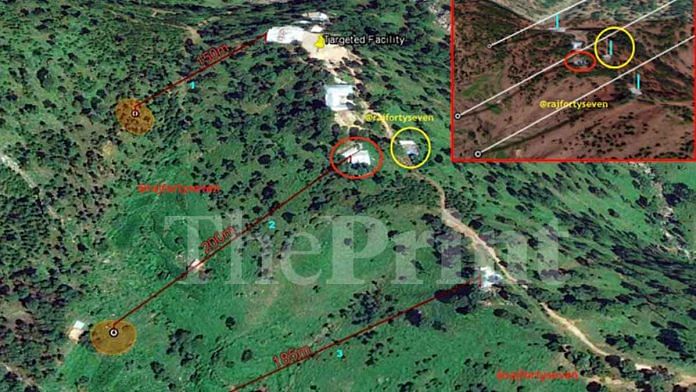



Even the photos in wire magazine giving credence to the Australian mention recent images while showing one year old images. This should be debated.
Thank you India for giving us the Israeli technology intact. Do you know why none out of 5 bombs dropped by IAF exploded?
Australian Strategic Policy Institute (ASPI) by ‘trying to sound definitive lays bare it’s bias’ especially when it’s inaccurate analysis is been exposed. Perhaps India’s successful tests of it’s anti-satellite missile capabilities recently, codenamed Mission Shakti, thus joining the elite club of achievers (USA, RUSSIA & CHINA) as a fourth member ‘will remove any doubts as to India’s prowess in this area of expertise.
ASPI ‘s reputation ‘if it had any’ is diminished.
Dear criticizers of air strike,only one thing you tell me if our military is saying false or they missed the targets then why Pakistan has not allowed foreign journalists to brief that striked area….have some mind,or else I think you lost your mind in criticizing our military and government
Because it was actually a terrorist camp, that’s why Pakistan didn’t allow anyone. Use your brain, don’t be andhbhakt. Satellite images show zero damage to the building.
Air strike is correctly targeted hit correct place killing atleast 300 terrorists but print ought to have publish this type of articles immediately in the morning of air strikes by showing the effected place then you more than 300 dead bodies then ought not dare to write this comments on our capabilities are you sleeping all these days and others who commented against that Air Force by changing their names are traitors of India they have to answer near future
Some readers have missed the point that this article is written by a retired Indian colonel and actually challenges the ASPI report. And they are blaming ThePrint as pro-Cong, pro-Pak etc.! It shows that the Bhakts have pea-sized brains.
bfr commenting in this manner & calling names read this experts original report which came to the wrong conclusion. s stop calling people names.
Ghar ki murgi daal barabar
Apni army pe bharosha Nahi karenge , magar falana dhikana kya kahega , usko maan lenge
Shame on you!
Army pe to poora bharosa hai lekin Modi pe minus zero bharosa. Aur doosri cheez, upar vale ne aadmi ko dimag kyo diya? Kya Isliye ke vo andha bharosa kar le?
Idiots !! These don’t believe Modi. He him self piloted the I A F plane and inflicted damages with a single bomb from Israel which penetrated thrice in three places, boring holes in to concrete and detonated inside the hideout that killed 350 terrorists and counted 300 active mobiles and sent the information to modi. Above all is the bombs did not rip open the roof top even though they exploded below roof and killed humans there only because they were Israel’s neutron bombs .
What’s the explanation for the buildings still standing?
Hahaha
Whole international media making fun of india
In reality approximately 19 tree damaged, nothing else.
Pakistan Surprised very next morning and shot down 2 Indian fighter jets, this is called capability and technique
Indian air force shot down its own mi 17 helicopter .
Costly weapons does not matters, skill matters.
lmfao bro ….yeah and the second pilot magically disappeared from pakistani hospital rig ht ??? delusional as always….atleast ….shooting of a f16 by a mig 21 lolol thats what skills are called…
There is a very simple method of verifying the claims and that is as follows. The reality is that the SPICE 2000 Air to Surface Missiles that were deployed through our Mirages, are State of the Art Technology. Essentially each Missile is fitted with a VIDEO CAMERA that continuously transmits images to the Mirages, till the very last millisecond till it strikes the target for which it has been programmed in advance.
The fact that the Modi Govt has not released these videos proves that the reporting by the international media holds true. The government has released Satellite images but they have been debunked. The only way to settle this controversy is for the Modi Government to release the Video evidence.
In fact there is need for a group of eminent citizens to file a PIL and appeal to the Supreme Court to ask the government to release the video footage of the Balakot strike.
You’re not supposed to release confidential info like that. This is was a defense operation not a fortnite game.
The Print, this country of 130 crore people do not need a certificate from you whites. We believe our military might and their capabilities you need not to worry. We have done it and will again till the destruction of nurseries of terror in Napakistan. Get prepared for the next….. ????
Vinayak Sir,
Are you differing with
(1) ASPI’s Assertion that the Bombs missed the targets?
(2) Or their Analysis on Why they missed??
Simulation analysises and real time responce are totally out of contrast especially for arial projectile. The analysis done by ASPI is not true as they used google earth and settalite images.
Let me tell ASPI that IAF aircrafts are equiped with indigenous systems and the accuracy to hit a target from 10km arial height is 0.25mR at Centre to 2mR at max.
Bombs can miss target by 2 maximum from a arial height of 10km. Hence, the artical published by ASPI is not valid.
The Print, if you have too much problem about air strike, why don’t you go Pakistan and click real picture and show us. You are journalist you can go there. Clear with us too by clicking your original picture. I think you have just one news which is about India’s air strike on Pakistan that had been failed according to you.
What i don’t understand ?
– ASPI imagery shows no holes on the roof
– yours does
Why aren’t they able to confirm what you have found.
Simple question without any complicated explanations. You found holes somewhere from imagery taken at a certain time, why can’t they corroborate it
What is the status of ASPI? Hearing of this Institute for the first time….. Is it an Australian Government Institute?
This author has no idea on how the SPICE 2000 bombs work. Your analysis is just nonsensical. The ASPI are reliable and accurate. Your assumptions are impractical from a technical standpoint. Ludicrous report
Though ASPI’s wrong assumptions were perfectly pointed out by thePrint but it is not true that international media was not allowed….the very next day I saw a BBC reporter who was by the way “INDIAN” go to the site and show that IAF missed the target by almost 100-200 mtrs and no casualty was inflicted….I think the govt has been using the military for political reasons
What a joke …..The Print is a joke itself and it’s usual …..from where they got this data of air strike …..ha…ha…ha…. nonsense media house …..according to Australian media 1971 indo_pak war was won by Pakistan …..it shows how much Australians r jewelous to India
None of the arguments hold water. A hypothesis cooked up using all worst case scenarios.
1- Indian airforce knows what’s been achieved and the intelligence is satisfied.
2- Not interested in making others believe.
3- Message sent Loud and Clear. Rules of engagement with Pak have changed for good : Period.
We trust our government and not ASPI..or any other media…
Like New Yark Time paper you The Print also Respected Modiji hater one. Burnol moment for these magazine because of Modiji’s good work and popularity.
Hahahhah
1) it’s not The print
it’s The Congress’s print company
2) it’s not the Print
It’s the Pakistan print
3) it’s not the print
It’s the Pappu prints
Hahahhah
You are reading The Print.
IAF was badly exploited by the selfish politicians for their selfish motives. At least they should have done some homework before the adventure. They were surprised by the prompt response of PAF. Infact as per Pakistan, the whole combat units of PAF were airborne, totally ready to engage any intrusion. The obsolete air defense system of IAF was also exposed the very next day when it shot down even their own helicopter.
ASPI could not tell about the missing aircraft in the Indian ocean. But they know all about secretly conducted planned and successfully executed airstrikes. We are proud of our air force and all armed forces. We owe them our endless support.
Why can’t we just criticize and discuss the analysis dispassionately instead of calling names and casting aspersion ? You have the analysis. Criticize it logically if you can or leave it ! People who want to vote Modi have made-up their minds just as Modi haters have made-up their minds some analysis by some Australian website is not going to change that !!!
Let’s assume that it missed the target and all the bombs fell elsewhere in the jungle. Then it must have had created lots of damages to the woods and Pakistan has the liberty to publish those pictures showing damages to the trees and may be parts of the missile. Why don’t they do so. Surely, these missiles did not evaporated mud air.
This is for election as always congress does, so ignore The Print.
Don’t believe it. Please prove it.. we hit target
It’s time for Pakistanis to give cooperation and prove this is right. They are not even allowing media or anyone to enter the targetted area.
You will definitely give negative news on modi as it was expected from you because in year 2011 you gave the fake newz on indian military action on indian government as it was said by p chidambaram( desh lootera )to you. And scamgress has paid for your 55 cr flat in chankya puri so how u can betray your malik.As kutta is alwayz faithfull to his malik.You r the real broker in news media .A media employee used to withdraw 10 cr
salary how it was possible. Wait after 2019 election result THE PRINT will only print wedding card of jailed scamgress politician
As the Col. assumes that the the coordinates were properly fed and there could not have been a miss. The probability that wrong coordinates were deliberately fed to very close to the targets is not examined.. It definitely could be the case .
What can we expect from those who sit in ac rooms and perform analysis for real time practicals…the elite of aspi are just the same…IAF has surely hit the mark… aspi forgot to take note of many other things…perhaps its the distance of vast Indian ocean between them and us and their limited reach to gather info is not beyond their own continent. I wish them best of luck to improve their resources and skills coz they don’t mis precision analysis and become experts like IAF. And it is common sense and not rocket science that pakistan is hit and badly hit and otherwise why would have many countries like usa uk france russia and even china to some extent asked India to maintain restrain for so called regional safety. If had India not bombed pakistan they would have been least worried about regional peace. But aspi is just so naive…or simply doing this bullshit analysis to gather crowds on their websites and increase their customer base to sell their idiot researchs…
People in India only believe in news published by Zee News, whose anchor was in tihar jail who caught in sting operation for blackmailing Jindal for crores of rupees.. Andhe Log
Typical of a intolerant deshbhakta attitude! What is wrong if some one else has their view point? It is because of Chaiwalas Jumla party bluff, every one takes news of India with pinch of salt! Don’t blame others, improve our credibility!!
Agreed
Apparently it’s gives us a clarity that ASPI and the print media is funded by PAK and also done some vested interest against the emerging & fusion technology from India
Simple analysis is if bombs were not on target then why pakistan government restricted international media to see that particular place? From more then one months they says NO for security reasons. This proves that bombs were on target.
Australian media was said India had loss 1971 WAR, nothing can do
The article/author/website themselves has disagreed with the Australian Institute’s findings. No point in blaming them and fighting amongst oursleves. I trust the Airforce, which never claimed specific numbers. This was done by politicians due to elections.
Good they have atleast said that JeM is actually there in Balacot. The Print should make more images showing Daud Ibrahim location too.
We indian belived our IAF and Modi
We indian belived IAF and Narendra Modi
Where is the satellite imagination of f16 claimed to be destroyed by Modi.
Is this (The Print), Published from Pakistan??
They might have taken skewed data from Analytica, funded by pak agents
This media is like a fly that sticks to dung. But fly (honey ?) searches for nectar
Jo ho Gaya so ho Gaya. Pata nahi kya ho Gaya. Sab jakar so Gaya.
Well if the targets were missed, then definitely Pak would allowed the media to visit the said places and shown them to the world. They have something to hide and so the restrictions are placed on the media from revealing the factual picture.
They did let the international media in the very same day. Reuters saw the bomb debris and the target was unharmed.
Come on guys, Be realistic, India Failed at Strikes, Accept it, and Pakistan really surprised this time, And Abhinandan was indeed a Brave son of Soil, Keeping aside his fate / Being shot down, he risked his life for all Indians, its better to accept Failures rather than continuously defending lies and Defeat.. PEACE..
I don’t understand why you have to publish what foreign agencies think on this. Can we show some trust and respect for what our Govt & Armed forces say and let it rest? Move on from Balakot, lot of action happening daily. Publish that!
Whites have a predisposition towards believing that only their granddad, US can carry out any military action successfully around the world. Like thier frackles, thier mental abilities are also patchy. Moreover they are like ostriches, they shove thier heads in the mud when they dont wanna see something in particular, such as a threat.
Western media is fundamentally racist and thrives on separatism and misinformation. It is enough for me if my IAF says the target was hit. The reaction by Pakistan prices beyond doubt that there was a strike. Jai Bharat!
Pak has not allowed anybody to visit balakote even after 1 month of strike. And don’t post your ground picture after they completed repair work . Give your story to ISPR ,they will give you visa to go there .
We don’t want any western bullshit. We trust our IAF chief .
Wrong
Lol. Nothing left to say imbecile
Stupid Australian don’t know to read data of their own satellite. All the black spots on green patch is DEBRIS of balalkot strike ..
As you and your story teller are supporting PAK narrative , then we have one question, why did not PAK allowed nobody to the site of strike ? Still nobody has been allowed to go there after 1 month of strike. Give your story to ISPR, they may allow you to go there. And please don’t post your pictures after PAK repaired holes in the rooftops and rectify internal damages.
The mood and the mindset of the country has been moulded in a way that there is no room for any difference of opinion or divergence from the government’s view or the official version. Placing oneself on the high pedestal of infallibility usually ends in a terrible fall. The only objective of this intellectual bankruptcy is to win elections – back to back five more years of lawlessness and downhill slide.
At least India is doing a good marketing at the world stage.It is must to market the country and create fear in the minds of Pakistan which this government knows how to do it and have the courage.only Muslim have problem with the government.Need proof after proof after proof .
I think the effect on the terrorists is more important than the academic justification that whether the bombs hit the target. If it hits, terrorists are eliminated, the effect should be seen in reduced terrorist activity. If not hit, do that again till terrorism stops. Our aim is not to test the accuracy of the missiles, or the capacity of IAF etc., but elimination of terrorists. Evaluation of the missiles, aircraft, ability of pilots etc., can be done by the concerned armed forces, defence ministry and so on.
The Print is Pro Congress.. So this news is not reliable..
Idiots Aussies think IAF isn’t capable of hitting it’s targets with precision. Jokers think only they can do a good job.
So the Aussies are also on the payroll of ISI! Firstly, just who are these jokers? I doubt if anybody has heard of them before. What is their credibility. This is not cricket where every bowler the Aussies cannot play is called for chucking. This is bordering on the ridiculous and madness
Whatever be the outcome of the strikes, can be debated. One thing I don’t understand the deliberate anti India and pro Pakistan mindset of the Western media.
Even in the Feb 28 air battle, the Western media widely published the shooting down of Mig 21 by a PAF jet. But no sentence about how Abhinandan shot down an F16 with his Mig 21.
My question is what is that you guys achieve with your anti India reporting??
The print is mouth piece of Congress party.so your news not reliable.
The Print. I want to ask you a question. Are you an Indian newspaper or a Pakistani one
Australian media can take a running jump. who cares. why do you have to publish their nonsense and confuse the people here. if you do not trust anyone one here go away
If so, why pak didn’t allow media to balkot attack site
How the author considered the tree shadow at 3.00 am in the morning.
No worries brother, we will do again and again on Pakistan..to ensure that terrorists gang will get the end of innings..???
Looks like the ASPI have a lot of time on their hands, or staff with a lot of time. Let them publish their shoddy analysis. They can open themselves up to ridicule.
If it is a ploy to make IAF reveal more info, ASPIcan exhaust all their options.
At least , they will expose their methodology to the world, and we can all be alert.We are not answerable to all and sundry for defending ourselves.
And to me, as a lay person, Pakistan’s response to the strike is guarantee of the hit. I trust my government , my Air Force and other service wings. They are not required to provide proof to me in public, and expose sensitive info.
God bless them!
Jai Hind!
Only the whites could do a perfect job.. Intelligence and perfection is related to melanin a skin protein.. Lesser melanin means white skin and more intelligence.. Please take a hike.. We believe our airforce did a perfect job and killed these imbeciles jehadis
This is the best comment brother…but i gues aspi lacks humour too…as they failed to gather precision information…for me its like look who’s saying…since 1st they fail to gather facts and then come out with stupid analysis…
You will have to because both the warring factions are not to give real picture.
What can one expect from western media …
Is the The Print publication of Pakistan?? Their news is always againts GOI and India.
Why don’t you mind your own business? We read in history your population is full of ex criminals and wanted in western world. Help yourself first.